| THIS WEEK'S ARTICLES |
| Larry Williams Focus On Stocks |
| MEMBERS ONLY |
| Santa Comes to Wall Street | Focus on Stocks: December 2023 |
| by Larry Williams |
|
Santa Comes to Wall Street Maybe St. Nick gets into the eggnog before he visits Wall Street each year, because the trading pattern has been a step up, then a stumble down before recovering at the end of the year...
|
| READ ONLINE → |
|
|
|
| The Mindful Investor |
| Pullback Imminent for Nasdaq 100 |
| by David Keller |
I think Friday's session was telling, in that the S&P 500 finished the week up about 1% while the Nasdaq 100 was nearly flat. The top two sectors on Friday's session were Real Estate and Industrials. The bottom two sectors? None other than the two top-performing sectors in 2023: Technology and Communication Services.
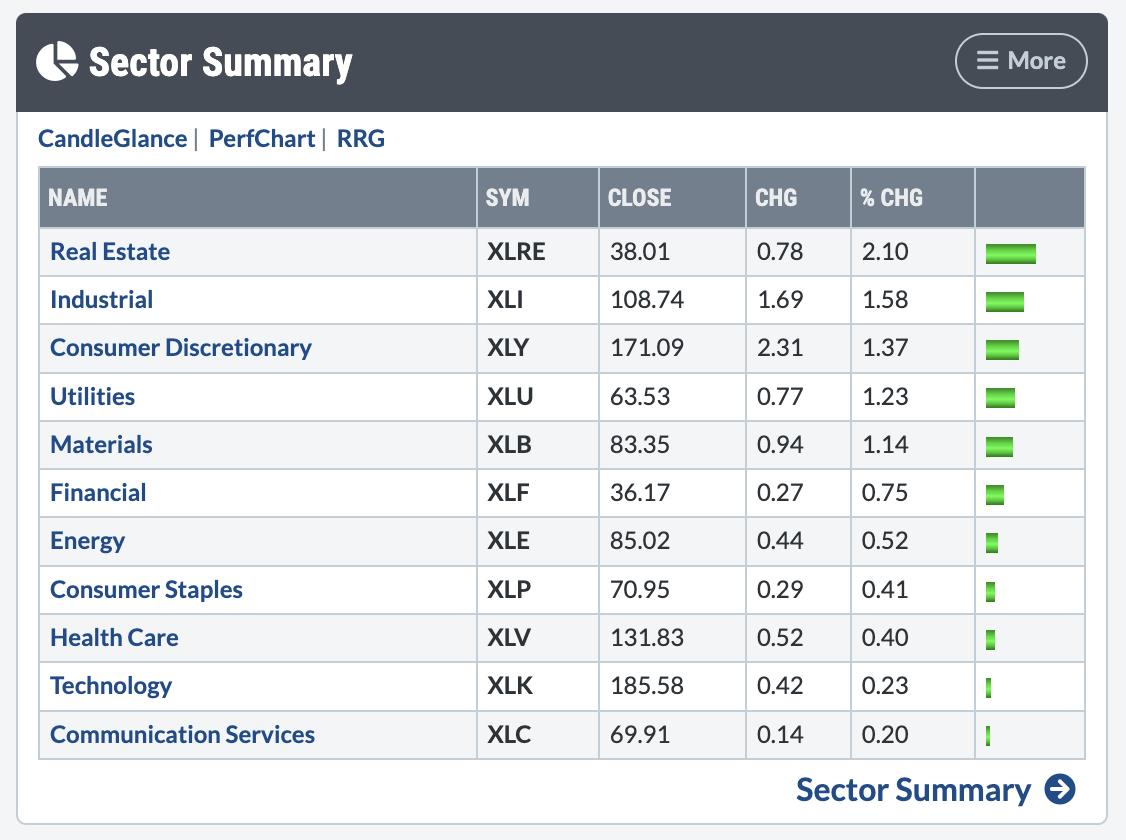
A small difference in returns, to be sure, but also a great indication that growth leadership names may be due for a pullback, while value sectors are not showing the same extreme momentum conditions.
A number of mega-cap growth stocks were overbought recently, and just as they were testing resistance from the summer highs. Charts like NFLX are perfect examples of this short-term bearish signal, where a stock that has a quick run higher often needs to take a break and reset before the uptrend can continue.
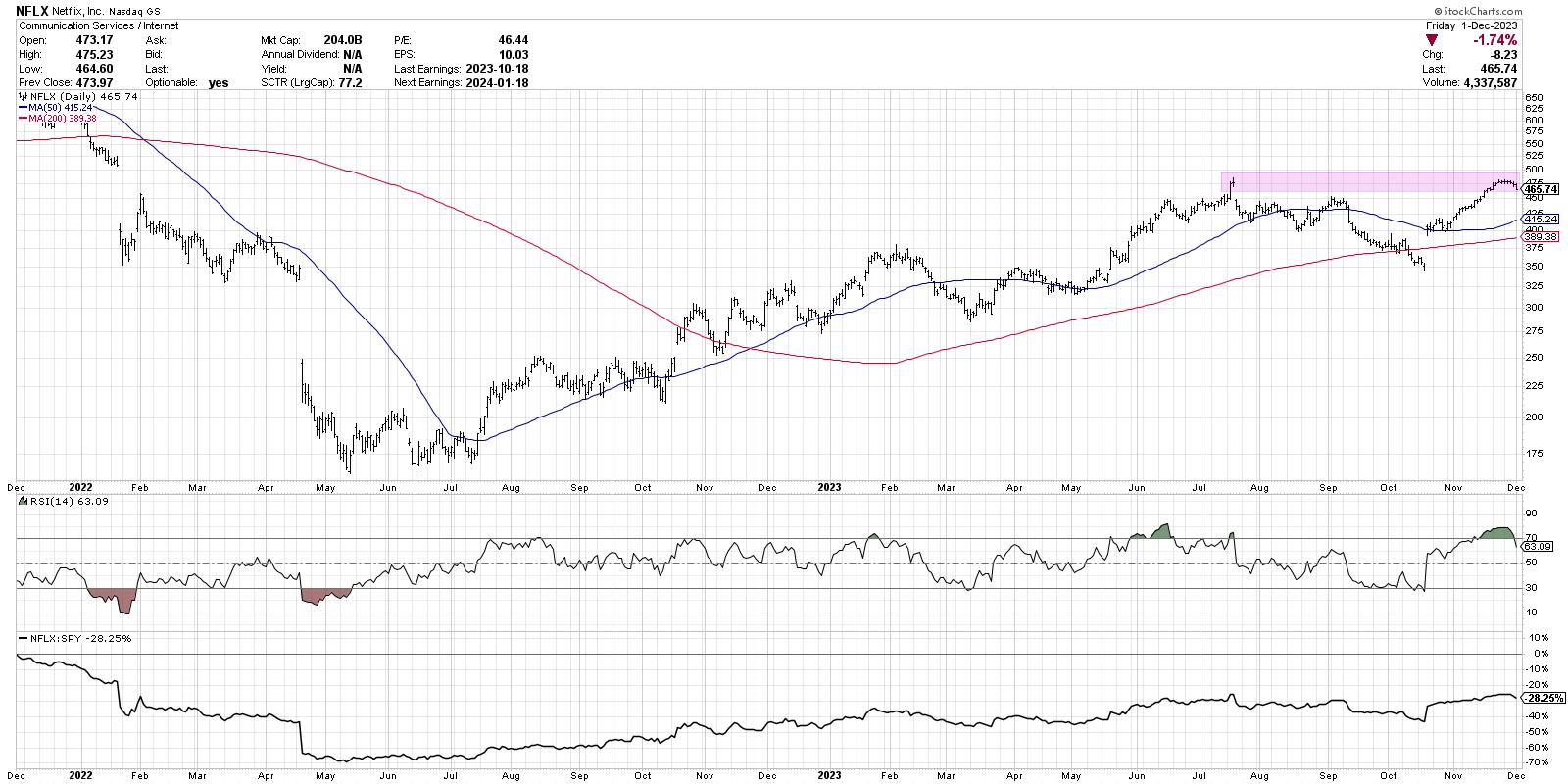
What could a pullback look like for the QQQ, and what would that mean for conditions heading into January 2024? And what other scenarios are a possibility for growth stocks? Let's lay out four potential outcomes for the Nasdaq 100, and I'll share my estimated probability for each scenario.
And remember the point of this exercise is threefold:
- Consider all four potential future paths for the index, think about what would cause each scenario to unfold in terms of the macro drivers, and review what signals/patterns/indicators would confirm the scenario.
- Decide which scenario you feel is most likely, and why you think that's the case. Don't forget to drop me a comment and let me know your vote!
- Think about how each of the four scenarios would impact your current portfolio. How would you manage risk in each case? How and when would you take action to adapt to this new reality?
Let's start with the most optimistic scenario, involving a new all-time high in January 2024.
Option 1: The Very Bullish Scenario
The most optimistic scenario would mean the last week was a bit of an aberration, a brief respite in the year of growth dominance. The Magnificent 7 stocks break higher into year-end, giving the Nasdaq 100 a new all-time high in January. Is that just the beginning of a supremely bullish 2024?
Given how stocks like GOOGL and NFLX have already dropped after showing signs of upside exhaustion, I don't see this as a likely option. But it's always good to think through the goldilocks scenario, if only to think through what signs could show it's becoming more likely.
Dave's Vote: 10%
Option 2: The Mildly Bullish Scenario
If you think growth stocks do pull back from their overbought conditions, and that the pause in this recent upswing delays any further rally into early next year, then this may be a more decent choice. The gap higher around $380 from a couple weeks ago after October CPI seems like a decent downside boundary for this mildly bullish scenario.
This one is really my base case here, as the seasonal patterns would suggest a strong December following a strong November. But I see signs of upside exhaustion in breadth indicators as well, and I would not be surprised if a pullback continues into mid-December.
Dave's vote: 60%
Option 3: The Mildly Bearish Scenario
What if the gap mentioned above does not hold, and an initial pullback in the Magificent 7 stocks ends up ushering in additional sellers who begin to fear a much further drop? Pullbacks in uptrends can be sudden and disorienting, and even if value stocks like Industrials and Financials manage to rally, it still wouldn't be enough to prevent our growth-oriented benchmarks from pushing lower.
I could see this happening given the severity of the rally off the October low, and that price gap around $380 is going to be an important level to monitor. It's hard not see charts like NFLX as a big double top right about now!
Dave's vote: 25%
Option 4: The Super Bearish Scenario
I always include a very negative and very unlikely scenario, because it helps to think about what risk factors could light up to warn of additional selling to come. If economic data in December comes in hotter than expected, or the Fed stresses that additional rate hikes are still on the table, or the Ten Year Treasury Yield turns back up toward 5%, then this could certainly happen.
A drop below the October lows seems incredibly unlikely, given the seasonal strength in December and how much growth stocks would have to drop coming off a very solid run higher. But it's best to think these options through before they actually happen!
Dave's vote: 5%
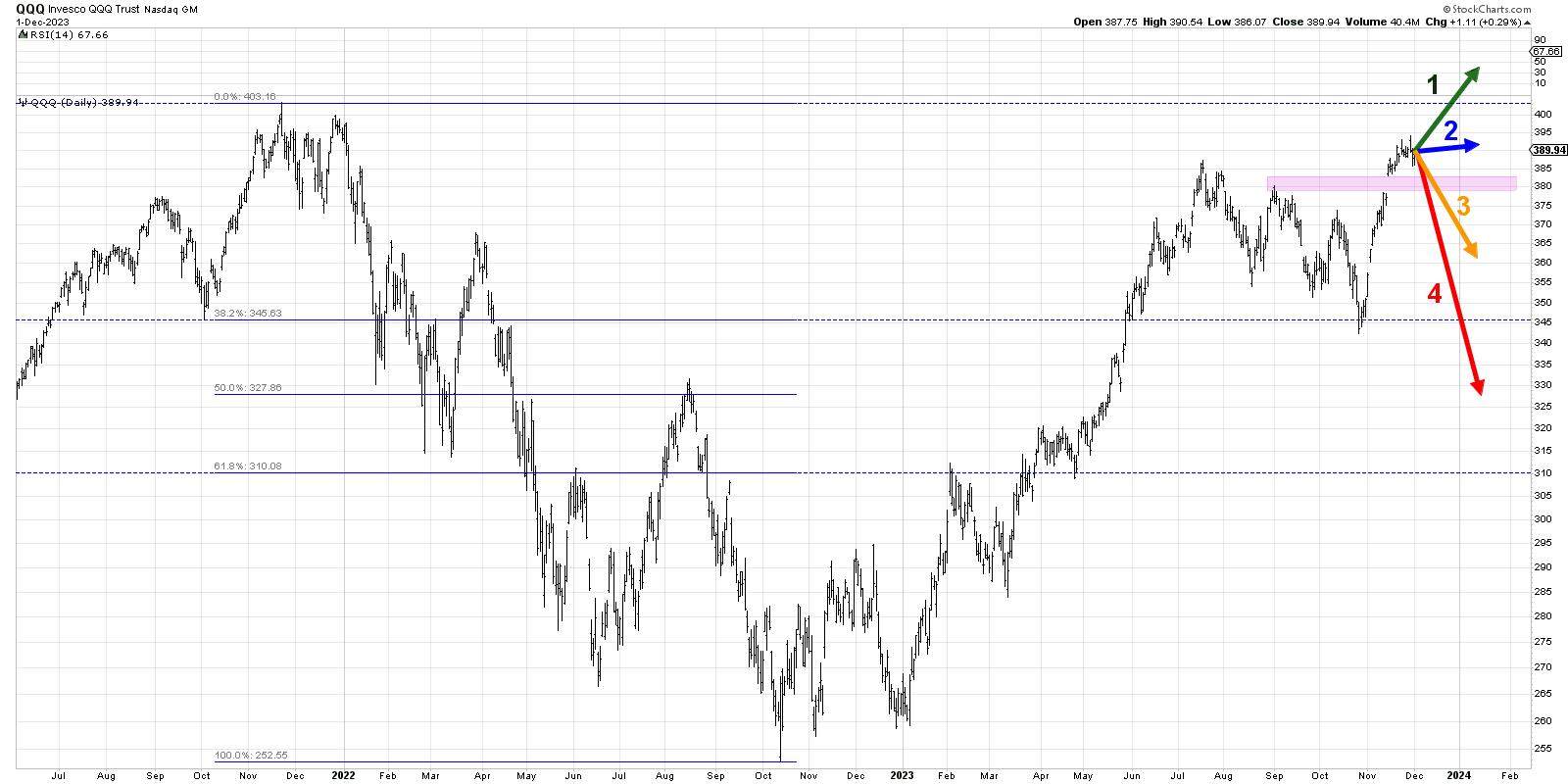
What probabilities would you assign to each of these four scenarios? We have two videos queued up to show you how each scenario may play out, and how we would assign probabilities to each of the four options.
Watch this one first, which outlines the four scenarios and how they could play out:
Then watch this one, which assigns the probabilities for each along with what motivated the results:
RR#6,
Dave
P.S. Ready to upgrade your investment process? Check out my free behavioral investing course!
David Keller, CMT
Chief Market Strategist
StockCharts.com
Disclaimer: This blog is for educational purposes only and should not be construed as financial advice. The ideas and strategies should never be used without first assessing your own personal and financial situation, or without consulting a financial professional.
The author does not have a position in mentioned securities at the time of publication. Any opinions expressed herein are solely those of the author and do not in any way represent the views or opinions of any other person or entity.
|
| READ ONLINE → |
|
|
|
| John Murphy's Market Message |
| MEMBERS ONLY |
| REITS, FINANCIALS, INDUSTRIALS, AND MATERIALS SHOW NOVEMBER RELATIVE STRENGTH |
| by John Murphy |
|
SECTOR SPDRS IN UPTRENDS... The number of sectors in rally mode has broadened out which is a positive sign for stocks. You may recall concerns in recent months that the market rally was too concentrated in large growth stocks and lacked market breadth. That's no longer the case...
|
| READ ONLINE → |
|
|
|
| The Traders Journal |
| Don't Even Think About Investing Without Addressing These 10 Essentials (Part 2: Essentials #6 - #10) |
| by Gatis Roze |
 I'm not an investment arsonist! I won't try to convince you that stock market perfection is achievable. I will, however, guarantee (strong word) that if you put in the effort, the results will be as Vince Lombardi often claimed: "Perfection is not attainable, but if we chase perfection, we can catch excellence." The 10 investing essentials I've presented in these two blogs were culled from my own list of 30 essentials. I believe you'll find them to be helpful. I'm not an investment arsonist! I won't try to convince you that stock market perfection is achievable. I will, however, guarantee (strong word) that if you put in the effort, the results will be as Vince Lombardi often claimed: "Perfection is not attainable, but if we chase perfection, we can catch excellence." The 10 investing essentials I've presented in these two blogs were culled from my own list of 30 essentials. I believe you'll find them to be helpful.
Two points to make. First, there are no shortcuts to becoming a successful investor. Your learning never stops. Yes, there are, at a minimum 20 more foundational essentials to learn. Second point: be willing to invest the time. Even Warren Buffett's vast net worth was predominantly accumulated after his 50th birthday. I share with you a quote from William Henley's poem "Invictus", whose final lines read "I am the master of my fate. I am the captain of my soul." Embrace this reality, and you'll achieve remarkable success in the stock market. Onward!
6. HERE'S YOUR CHALLENGE
You either embrace "PAC", or you PACK IT IN and give your money to some money manager. PAC stands for PIVOT, ADAPT and CHANGE. This is a reality of investing and a truism of the stock markets. Expect and accept change. William O'Neil preached that following new products and new companies leads to growth, profits, and rising earnings. These disruptors or change-makers are the future darlings of the equities markets.
Even something as seemingly mundane as grocery store inventory can reflect the impact of regular changes. Few realize that 80% of what's on the shelves today are new or improved products that have been there for five years or less. Think food trends and fads. The days of Campbell soup gave way to healthy organic and sustainable foods lower in salt and preservatives. The stock market reflects these types of changes in our society. Your portfolio must change with the times, too. As Nicolas Darvas wrote in his seminal 1960's book, "There are no good or bad stocks — only rising and falling stocks." Accept this fact, embrace the challenge, pivot, and adapt. PAC!
7. INVESTING DEMENTIA
There's the good kind of investing dementia and the bad kind. Understand both!
Exceptional professional athletes become adept at the good kind. Sports require a short memory. What happened with the last play, last goal, or last period mustn't negatively impact the next play, next goal, or next period. The bad kind applies to everyone — be it in the sports arena, business world, investing theater or life. When you don't acknowledge mistakes you've made, and thereby make them again, that's pure stupidity. Or you simply forget the lessons you've learned, thereby losing sight of the past and not remembering what you had once known. You get lazy, and allow your ego to tell you something different. Yes, it takes focus, concentration and discipline to learn from your mistakes and remember not to step into the same cow dung twice. Stan Druckenmiller — the ‘Market Wizard' — once said, "Every great money manager I've ever met, all they want to talk about is their mistakes. There's a great humility there." A big ego and a selective memory is a toxic mix in the investment coliseum.
Investing attracts many successful people with high IQs. All too often, these folks bring their oversized egos to the table, accompanied by a fair amount of psychological baggage that they didn't realize they had or didn't think mattered. The markets have a way to ensure that these folks do a belly-flop and lose their bathing suits. Intuition and IQ have little relevance in the stock market until they're backed up by the prerequisites of competence and expertise. That takes a committed effort over time.
An immense part of that is what we address in Stage 3 of Stock Market Mastery: The Investor Self. If you truly embrace the fact that the majority — yes, I said majority — of your consistent long-term success in the markets depends upon your mental skills and self control, then you'll be a winner. You will steadily and predictably progress through the five levels of investor growth. Just remember, egos are toxic in investing.
8. THE IMPORTANCE OF A METHODOLOGY
If you can't explicitly describe your investment methodology, you probably don't have one! Start by putting it down in writing. Once you've outlined your investing approach, I submit to you a number of good things will happen.
- You'll feel less stressed.
- You'll stay more organized.
- The market will reward you for your efforts.
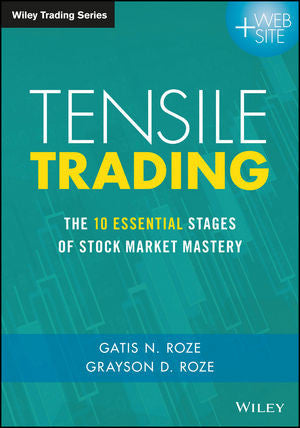 I humbly suggest you use our book Tensile Trading: The 10 Essential Stages of Stock Market Mastery as a foundation, and then personalize it over time as you deem fit. Think of it as a roadmap to help peel back the 10 layers of the stock market. You'll clearly recognize there's DNA from many Market Wizards incorporated in each of the 10 Stages. This approach is the antithesis of reading newsletters and accepting stock tips. Instead, this is all about learning a skill set you can replicate. I think this ancient and timeless wisdom remains so very apropos for modern investors. "Give a man a fish and you feed him for a day. Teach a man to fish and you feed him for a lifetime." A profound truth we should all embrace as investors. I humbly suggest you use our book Tensile Trading: The 10 Essential Stages of Stock Market Mastery as a foundation, and then personalize it over time as you deem fit. Think of it as a roadmap to help peel back the 10 layers of the stock market. You'll clearly recognize there's DNA from many Market Wizards incorporated in each of the 10 Stages. This approach is the antithesis of reading newsletters and accepting stock tips. Instead, this is all about learning a skill set you can replicate. I think this ancient and timeless wisdom remains so very apropos for modern investors. "Give a man a fish and you feed him for a day. Teach a man to fish and you feed him for a lifetime." A profound truth we should all embrace as investors.
9. DISCIPLINE
Having the discipline to follow your routines is what separates the winners from the losers. Successful investing is not dissimilar to professional sports. For a championship result, it's all about doing a myriad of little things that add up to achieving a significant result; small routines which reinforce each other. Not dissimilar to the elements that make up your investment methodology and stack atop one another to create a basket of probability enhancers. The stock market is all about probabilities. You must endeavor to find each and every element that will contribute to increasing positive probabilities and adding these to your investing methodology.
In fact, this is not the biggest challenge. Our book is chock-full of these probability enhancers. We can teach that. But the Achilles heel for most investors is not having the discipline to consistently deploy their routines. If you waver or allow yourself to become lackadaisical, you will ignore something or miss something altogether. The market will catch your blindness and extract the requisite tuition.
Market Wizard Richard Dennis claimed he could publish his trading methodology and rules in the newspaper and very few investors would follow them . Why? He knew so few would ever have the discipline, drive, and commitment to put in the effort. Discipline is your shield to the dark side. The golden road to the rainbow is paved with discipline.
10. FACTS, JUST THE FACTS
Truth holds power. These days, however, the Investment Salad is composed of information, disinformation and artificial intelligence, which I refer to as synthetic truth. Discerning the truth is an ongoing battle. Social media has created a dense stock market fog with a medley of distortions, bias, lies, propaganda, and misinformation, as well as deliberate disinformation.
The first truth to embrace is that truth itself is not always easily available. The second truth is that there exists a lot of disinformation haze. Seldom will you have clear sight lines. Having acknowledged these truths, I follow eight simple caveats that have served me very well over time. I'd like to share these with you.
a. Fact-check what you can.
b. Do not put much faith in the so-called experts.
c. You'll never know everything you'd like to know. Get used to it.
d. Don't focus too much on short-term sensational news.
e. Don't believe it when the pundits claim "it's different this time."
f. You must be willing to adapt and change when reality presents itself.
g. An historical truism of stock equity prices — the cheap get cheaper. The dear get dearer. Don't fight it.
h. My favorite caveat: Price charts don't lie. I trust them. I believe in their message. They are the final arbitrator.
BONUS: A gift to you this Holiday Season. Being immersed in Black Friday and Cyber Monday sales, I thought it only reasonable to extend to you my own December Deals.
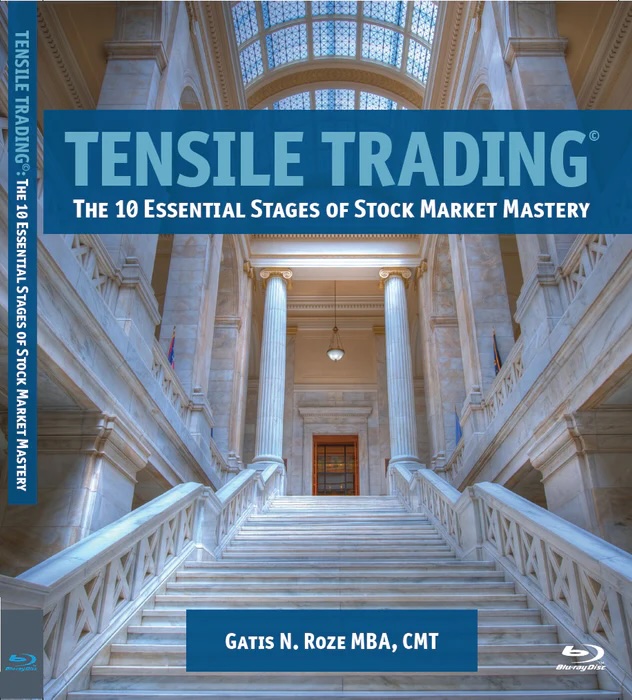  Our Blu-Ray had been steeply discounted for those of you who might prefer to watch DVDs versus reading our book — The 10 Essential Stages of Stock Market Mastery. Our Blu-Ray had been steeply discounted for those of you who might prefer to watch DVDs versus reading our book — The 10 Essential Stages of Stock Market Mastery.
The Asset Allocation DVD that Grayson and I produced is also steeply discounted. This is another great stocking stuffer for parents endeavoring to boost the financial IQ of the younger generation.
Wishing you great investing success in 2024!
|
| READ ONLINE → |
|
|
|
| Trading Places with Tom Bowley |
| What A Week! This Small Cap Party Might Just Be Getting Started |
| by Tom Bowley |
Last week, in my Weekly Market Report to EarningsBeats.com members, I pointed out the upcoming bullish history of the small cap Russell 2000 Index (IWM tracks this index). Most probably have no clue why small caps outperformed by such a wide margin this week. But history saw it coming all along. Here are the daily annualized returns on the Russell 2000 since 1987:
- November 23: +63.10%
- November 24: +255.15%
- November 25: +78.57%
- November 26: +22.50%
- November 27: +28.95%
- November 28: +72.16%
- November 29: +38.77%
- November 30: +44.22%
- December 1: -39.02%
- December 2: +121.88%
- December 3: -26.06%
- December 4: +22.88%
- December 5: +157.14%
- December 6: +52.01%
- December 7: -34.93%
- December 8: +90.60%
There's a lot of historical tailwinds at our back right now. It's a clear seasonal indication that the IWM LOVES this time of year. Historically, the IWM's best two calendar months are December and November, which have produced annualized returns of 25.08% and 17.46%, respectively, since 1987. Only three other months are even in double digits: April (+15.25%), May (+13.10%), and February (+12.89%).
So should we be shocked to see the following IWM chart:
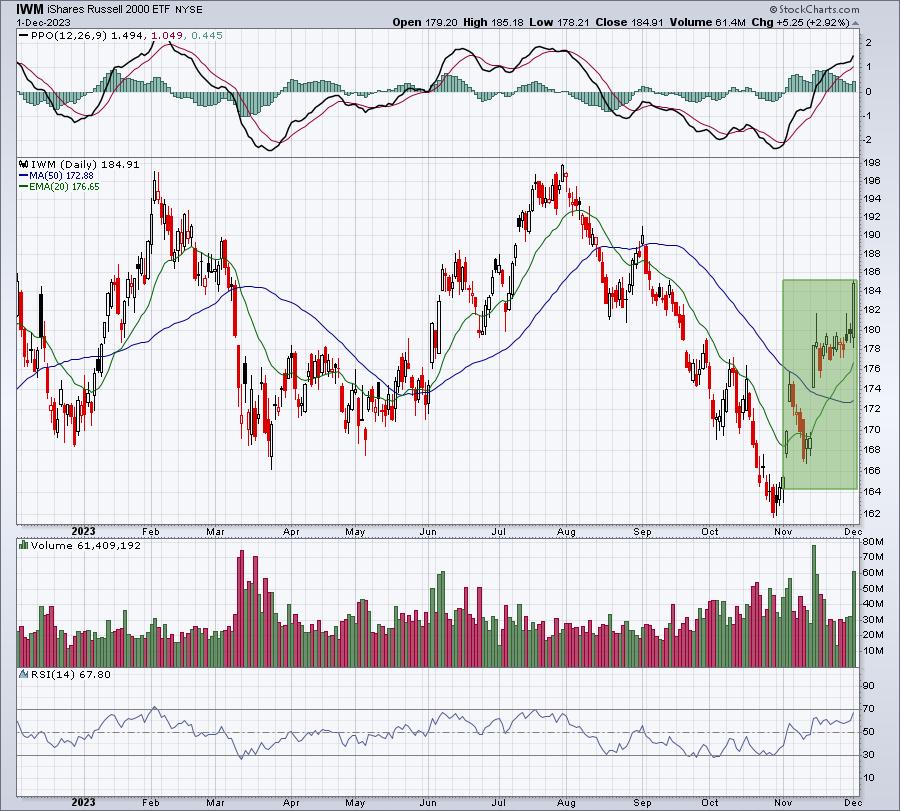
It's easy to see what's happened thus far in November/December. And just think, December is typically stronger than November and it's just getting started.
Looking at the IWM another way, this time from a technical perspective, also yields a very bullish December outcome:
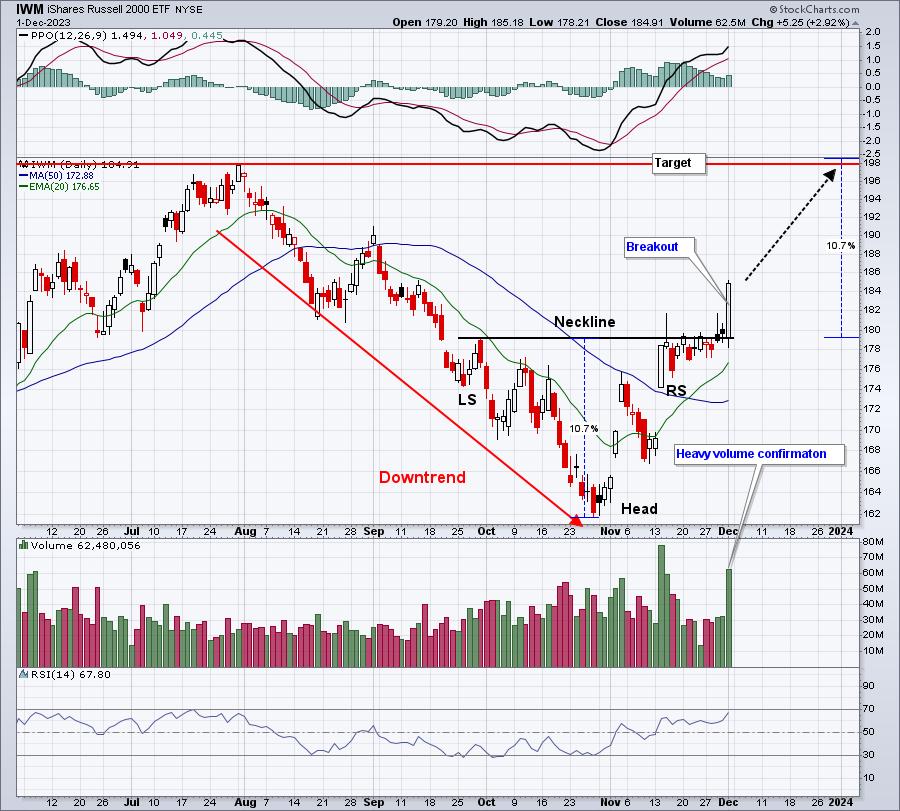
I see a beautiful reverse head & shoulders bottoming pattern that executed today. Volume soared to accompany the price breakout above the neckline. Listen, none of this is surprising to me. I've been telling members since June 2022 that the longs were in a much better position than the shorts. It was time to STOP shorting in June 2022. The S&P 500 is now up 1000 points off the ultimate October 2022 low. The NASDAQ 100 has risen nearly 50% from the June 2022 bottom.
And you know what? We're going higher. A lot higher.
To improve your own trading success, answer these two questions honestly:
(1) Do you know there's a 12-consecutive day period of EVERY calendar month that has produced more than 80% of the S&P 500's gains since 1950? In other words, a little more than 33% of all trading days have accounted for more than 80% of the market's gains. Do you WANT to know what that period is? I would certainly hope so!
(2) Do you know the trading behavior of each calendar quarter? That knowledge recently led me to very profitable trades on both NVIDIA Corp (NVDA) and Tesla, Inc. (TSLA), 2 of 16 key stocks that I've done extensive historical trading analyses for. Want to improve your trading success with simple seasonal data? Why wouldn't you?
I want to introduce you to "Bowley Trend: Long-Term Trends Since 1950". It's a 7-page PDF that I want you to immediately download and keep as yours. Consider it a "Thank You!" for following my work over the years. Learn the secrets that few traders know. Take one minute, CLICK THIS LINK, and download my FREE PDF that will change the way you look at the stock market forever!
Happy trading!
Tom
|
| READ ONLINE → |
|
|
|
| Martin Pring's Market Roundup |
| MEMBERS ONLY |
| Three Markets That are Right At Significant Breakout Points |
| by Martin Pring |
|
A lot of the time, I write articles that focus on markets or technical situations that should be monitored for a potential turn. This one is no different, except to say that these markets are not close to breakout points, but right at them. In short, it's fish-or-cut-bait time...
|
| READ ONLINE → |
|
|
|
| Don't Ignore This Chart! |
| SNAP's Stock Price Snaps Out Above Bollinger Band -- Could This Be a Profitable Opportunity? |
| by Jayanthi Gopalakrishnan |

Snap Inc.'s stock (SNAP) price exceeded its upper Bollinger Band. But what does this mean for the stock's price move?
To start, a move above a Bollinger Band isn't necessarily a signal to buy. It's more of an indication of strength, and that strength could extend into something bigger and stronger.
In the daily chart of SNAP below, price "walked the band" from October, gapped up in early November, pulled back a bit, and then gapped up again. There's a chance that SNAP's price can "walk the band" with several touches if the uptrend is strong. But will the trend be strong, or will SNAP's strong price move fizzle out?
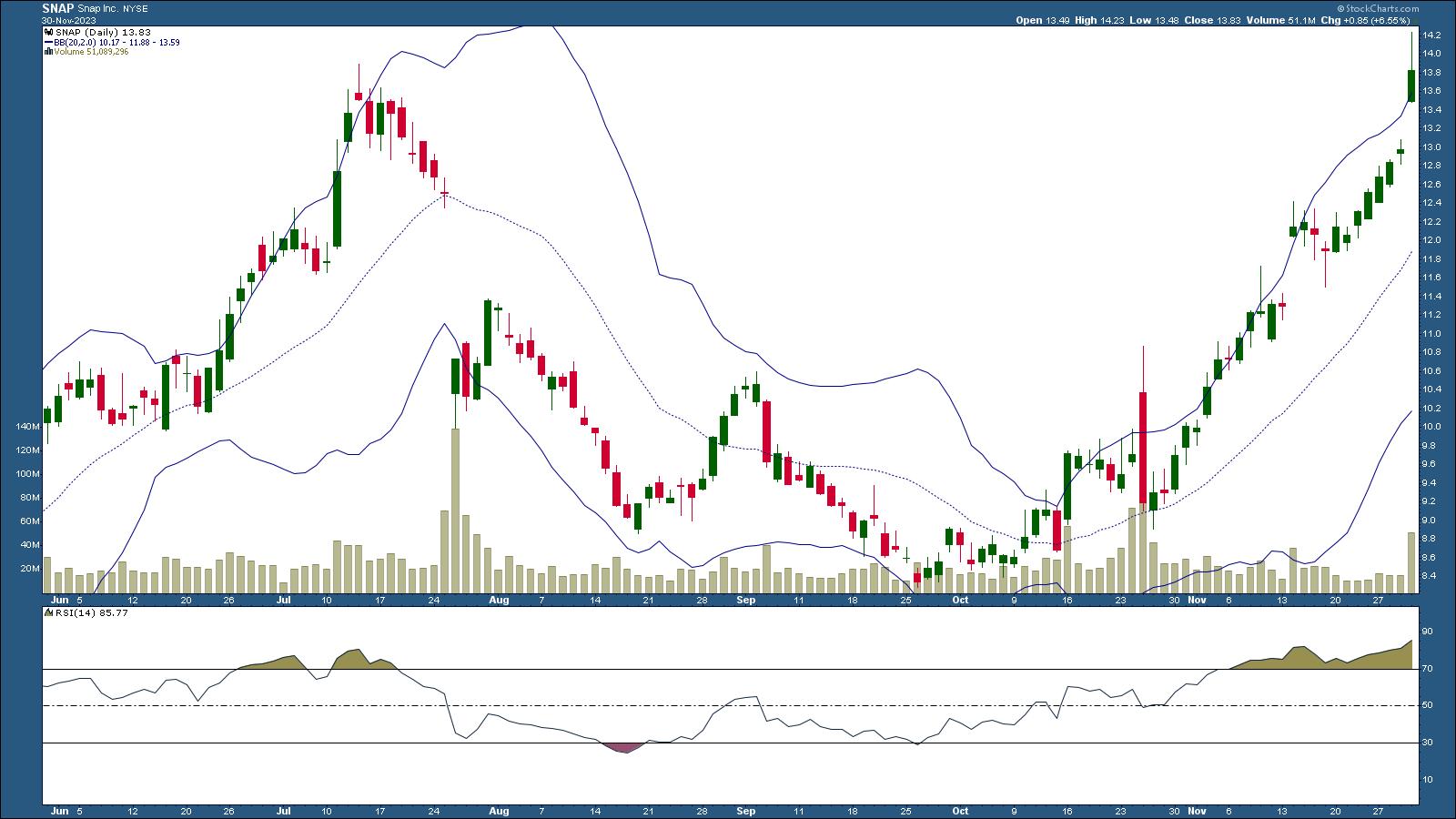
CHART 1: DAILY CHART OF SNAP, INC. Snap's stock price exceeded its upper Bollinger Band, which is an indication of strength. But is the strength enough to push this stock higher?Chart source: StockCharts.com. For educational purposes.
Generally, when looking at Bollinger Bands, the 20-day SMA can sometimes act as a support level. But on the daily chart, SNAP hasn't pulled back to that level since late October, the early stage of its uptrend. So, when you see a move such as the one in SNAP, it doesn't hurt to add a momentum indicator such as the relative strength index (RSI) to your chart.
The RSI is at 85.77, which is an indication the stock is overbought. There's a chance the stock could remain overbought for an extended period of time.
The stock has a few things going for it.

- It hit a new 52-week high.
- It gapped higher.
- Volume spiked.
If this momentum continues, it could take the stock higher, the stock could continue moving up along the upper Bollinger Band, and it could remain in an overbought RSI territory for an extended period of time. But how much higher can SNAP go? For that, you'll have to look at a longer-term chart.
Looking at a 5-year weekly chart, you can see that SNAP's ride to its all-time high is a long way away (see chart below). The stock has been basing for over a year. There needs to be much stronger upside momentum to push the stock higher. Breakouts from basing patterns are often good trading candidates. If SNAP does break above this pattern on strong momentum, it would be a good long position to add to your portfolio. For this reason, SNAP is worth watching.
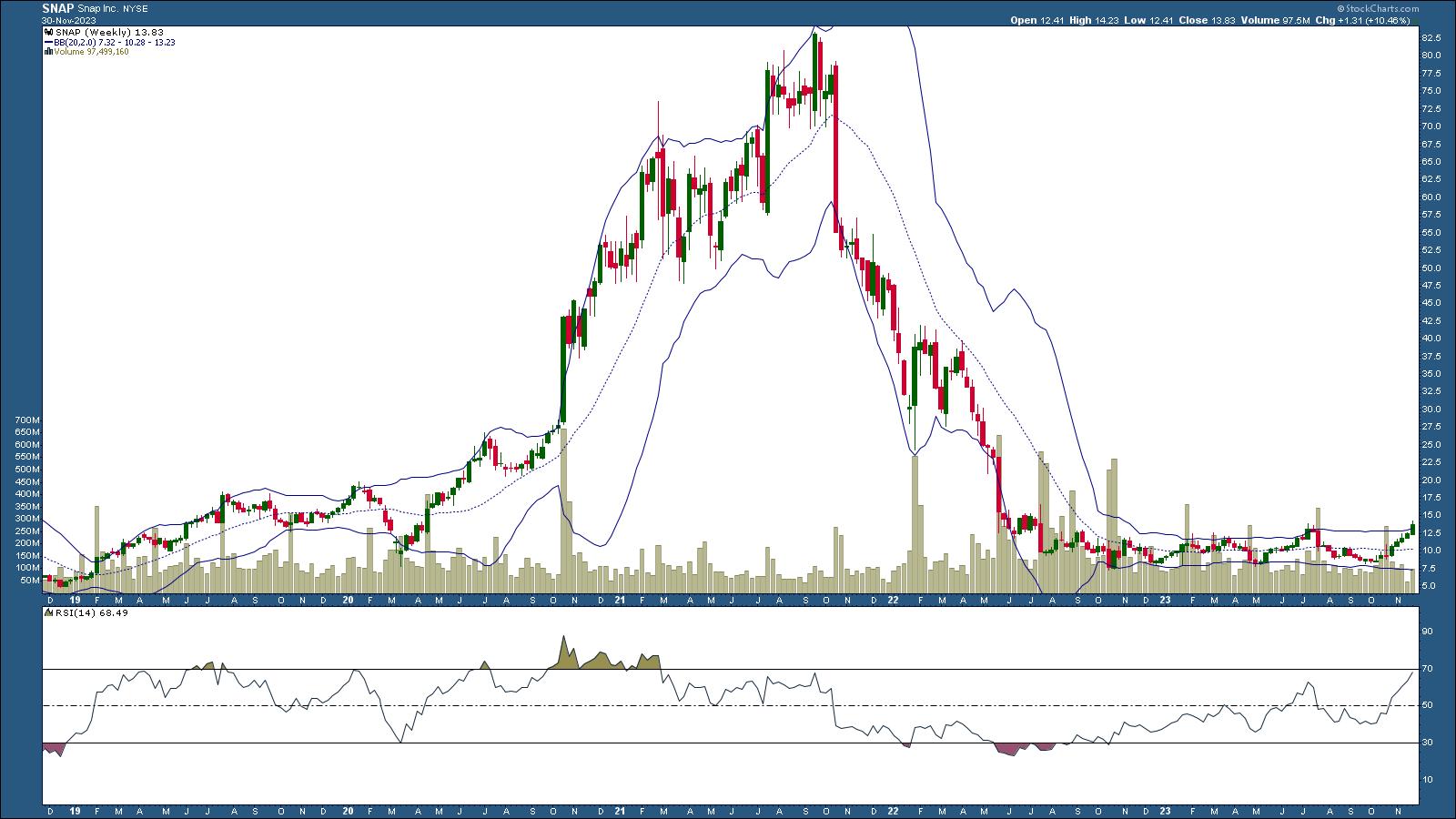
CHART 2: WEEKLY CHART OF SNAP. The stock is trading close to its low and has been trading sideways for over a year. A strong move higher could see this stock break out to the upside and make its way towards its all-time high.Chart source: StockCharts.com. For educational purposes.
The Bottom Line
Add SNAP to your ChartLists and set an alert for price crossing above $15. If it does that, monitor the stock, and if an uptrend (series of higher highs and higher lows) is established, you may want to jump on board.
How To Create An Alert in SharpCharts
- From Alerts, select New to create a new alert.
- Enter the stock symbol.
- Select the Trigger.
- Select how you wish to be notified.
- Save alert.
Disclaimer: This blog is for educational purposes only and should not be construed as financial advice. The ideas and strategies should never be used without first assessing your own personal and financial situation, or without consulting a financial professional.
|
| READ ONLINE → |
|
|
|
| DecisionPoint |
| Wrong Data Gets Wrong Answers |
| by Carl Swenlin |
A recent article on the Business Insider site reported a set of Death Cross/Golden Cross signals on the Dow Jones Industrial Average ($INDU). Specifically, on November 13, the 50-day moving average crossed down through the 200-day moving average, commonly called a Death Cross. Two days later, the 50-day moving average crossed back up through the 200-day moving average, commonly called a Golden Cross. I was surprised by this claim because I follow the Dow and these crossovers, and I had not observed such events.
I quickly discovered the problem. The symbol $INDU is the official Dow Jones Industrial Average, but the problem is that the data for this symbol are not adjusted for dividends, as with the data for stocks, mutual funds, and ETFs. In fact, none of data for the major market indexes ($SPX, $NDX, $NYA, $COMPQ, etc.) are adjusted for dividends, so if you want to perform technical analysis on them, it is best to use the corresponding ETF.
This chart illustrates the point. Adjusting prior data for dividends changes the price index into a total return index by incorporating dividends into the data.
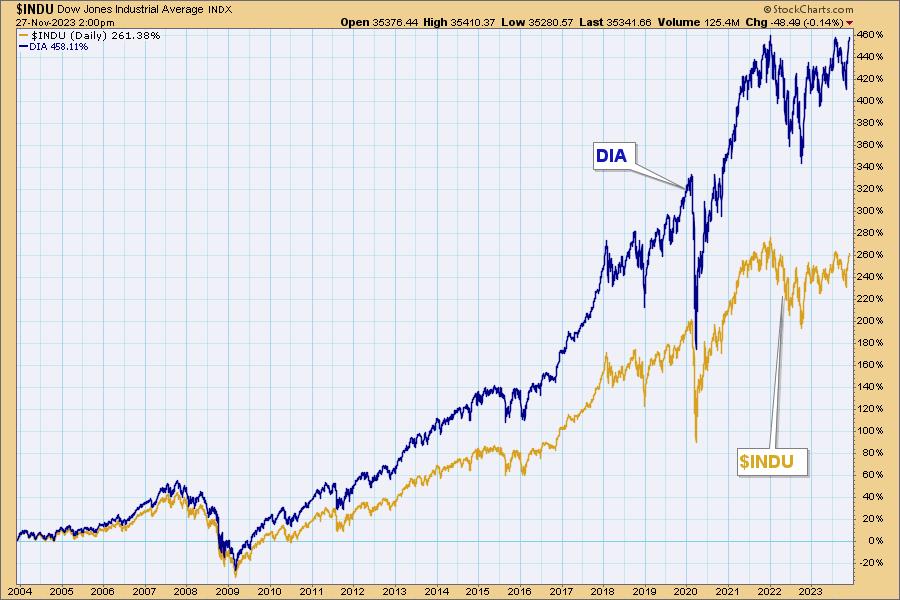
Now here is a chart using $INDU data. Note the whipsaw.
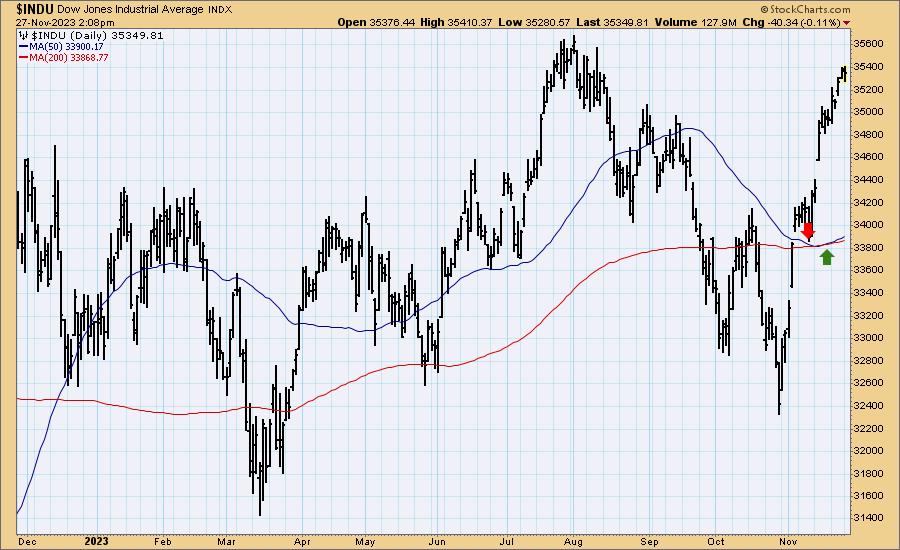
Here is a chart using the Dow Jones Industrial Average ETF (DIA). The whipsaw never happens.
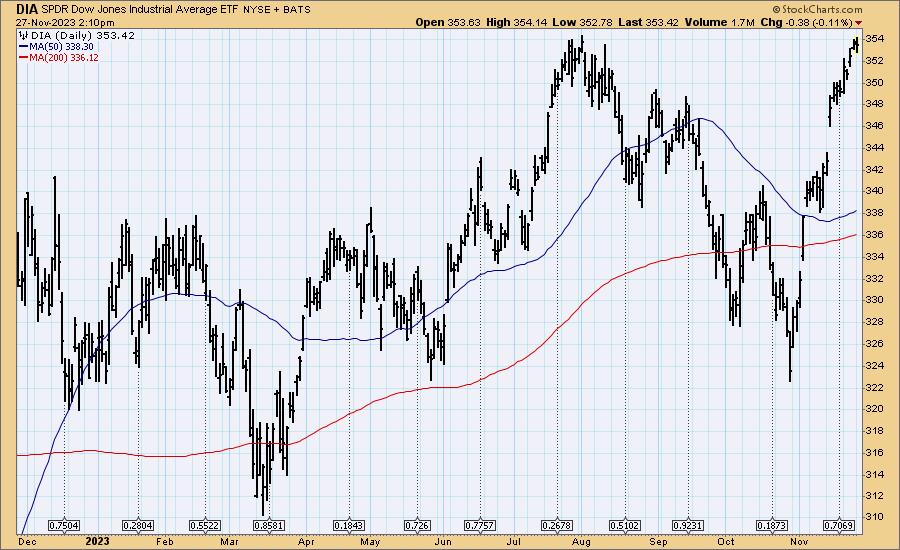
While the data for major market indexes is not adjusted (probably to avoid confusion regarding historical references), there are data sets other than ETFs available, usually called total return indexes. For example, symbol for the total return index for the Dow is $DJITR. Personally, I prefer the ETF.
Conclusion: When performing technical analysis, be sure that the data is adjusted for distributions (dividends and splits). Charting services like StockCharts.com perform the calculations as a matter of course.
Learn more about DecisionPoint.com:
Watch the latest episode of DecisionPoint on StockCharts TV's YouTube channel here!

Try us out for two weeks with a trial subscription!
Use coupon code: DPTRIAL2 at checkout!
Technical Analysis is a windsock, not a crystal ball. --Carl Swenlin
(c) Copyright 2023 DecisionPoint.com
Disclaimer: This blog is for educational purposes only and should not be construed as financial advice. The ideas and strategies should never be used without first assessing your own personal and financial situation, or without consulting a financial professional. Any opinions expressed herein are solely those of the author, and do not in any way represent the views or opinions of any other person or entity.
DecisionPoint is not a registered investment advisor. Investment and trading decisions are solely your responsibility. DecisionPoint newsletters, blogs or website materials should NOT be interpreted as a recommendation or solicitation to buy or sell any security or to take any specific action.
Helpful DecisionPoint Links:
DecisionPoint Alert Chart List
DecisionPoint Golden Cross/Silver Cross Index Chart List
DecisionPoint Sector Chart List
DecisionPoint Chart Gallery
Trend Models
Price Momentum Oscillator (PMO)
On Balance Volume
Swenlin Trading Oscillators (STO-B and STO-V)
ITBM and ITVM
SCTR Ranking
Bear Market Rules
|
| READ ONLINE → |
|
|
|
| Don't Ignore This Chart! |
| MSFT Stock At Record High: Is Now the Time to Buy Before It Skyrockets Further? |
| by Karl Montevirgen |
While Microsoft's (MSFT) Azure contends for the top spot in the cloud computing arena, trailing behind Amazon (AMZN), its $1 billion investment in OpenAI, and the hand it played in resolving the company's recent debacle, shows how prominently Microsoft is riding the AI tiger.
Investors, too, must be getting the message, as the market has pushed MSFT's stock beyond its 52-week high threshold.
How To Scan for Stocks Making New 52-Week Highs
- In SharpCharts, from Your Dashboard, scroll the Member Tools on the left and click on Sample Scan Library.
- The New 52-Week Highs scan is the second from the top on the left side.
The stock went above $379.00 in Wednesday's trading session, and, with no historical resistance ahead, anyone looking to go long might wonder where a good entry price to open a position might be, despite a slight pullback.
At the end of 2022 and the beginning of 2023, MSFT bounced off its 200-week simple moving average. At least that gave bulls a reference point, with both serving as ideal entry points (see weekly chart of MSFT below).
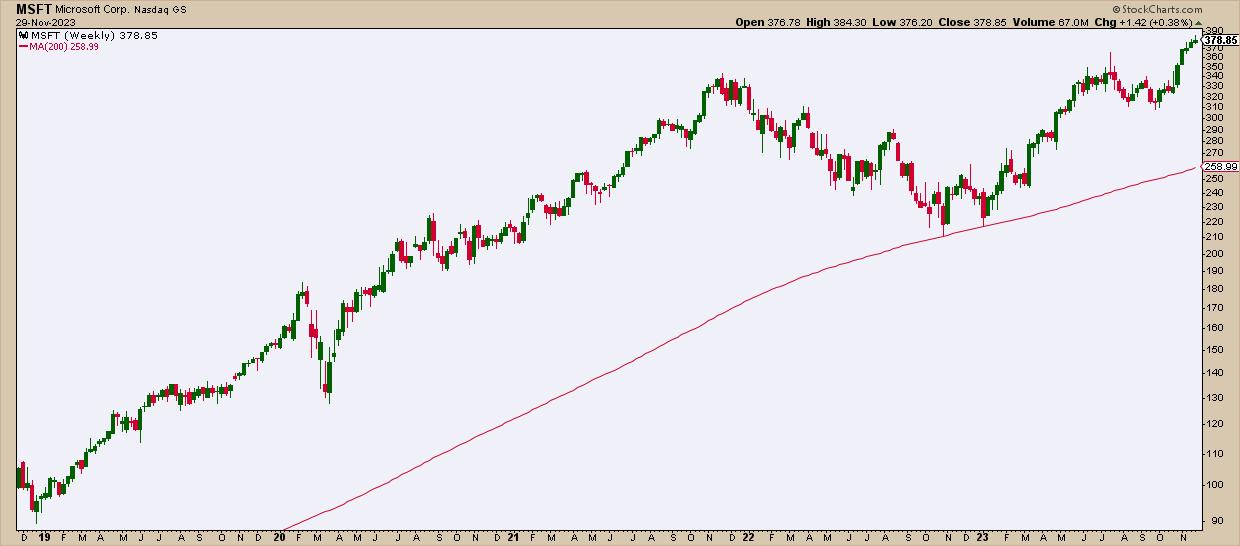
CHART 1: WEEKLY CHART OF MICROSOFT STOCK. The stock is in all-time high territory. Where to from here?Chart source: StockCharts.com. For educational purposes.
But having broken above its all-time high threshold, it's hard to tell whether MSFT stock is skyrocketing or whether its sky-high valuations are subject to the forces of market gravity.
Also, fundamentally-based projections aren't much help here—they range anywhere from $390 to $450 a share. So, if you're looking to go long, it helps to assess whether the stock is currently overbought and if a dip might be forthcoming. For that, we'd have to look at the daily chart of MSFT stock (see below).
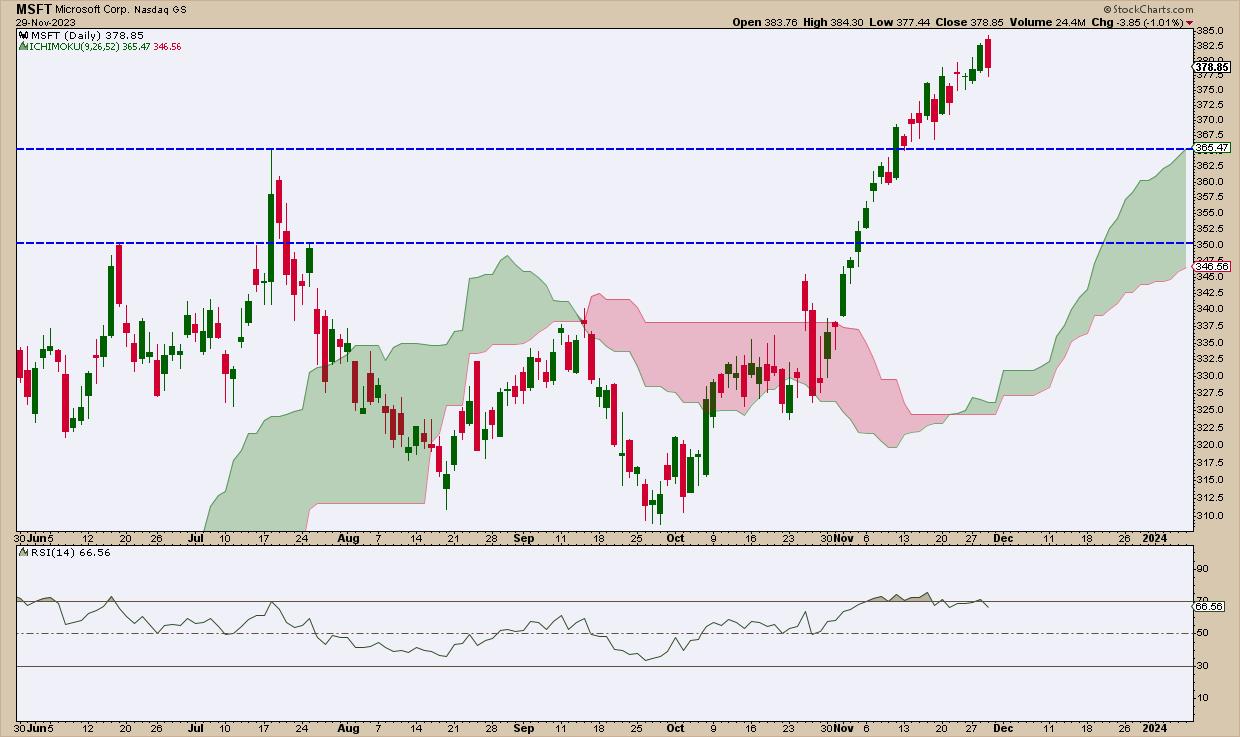
If you look at the relative strength index (RSI), now falling from 70, you can spot a slight divergence between the price rise and the RSI declining from "overbought" territory. MSFT may be pulling back now, but it's too early to tell if the pullback will continue in the coming sessions.
If it does continue to slide, we're looking at former resistance-turned-support levels as possible prices to anticipate a bullish bounce. This is punctuated by a thickening bullish Ichimoku Cloud, which, if you can remember, provides a range of potential support.
Why the cloud? The wider range complements the specific price support levels of $365 and $350. A pullback to this range, starting at the top-most $365 level and followed by a bounce, might provide you with an optimal entry point to get long MSFT, should you want to add it to your portfolio.
Note January 31, 2024 on your calendar. That's when MSFT drops its next earnings report. Right now, the buying craze is also centered on its ties with OpenAI. So keep an eye on any developments or news as we count down to January of the new year.

Disclaimer: This blog is for educational purposes only and should not be construed as financial advice. The ideas and strategies should never be used without first assessing your own personal and financial situation, or without consulting a financial professional.
|
| READ ONLINE → |
|
|
|
| Investing with the Trend |
| The Hoax of Modern Finance - Part 1: Introduction |
| by Greg Morris |
Note to the reader: Over the next couple of weeks and months, I will be republishing the contents of my book, "Investing with the Trend," in article form here on my blog. I'm calling this series "The Hoax of Modern Finance" for reasons you will learn below. Hopefully, you will find this content useful. As always, let me know what you think in the comments area below the article. - Greg Morris, Nov. 2023
CHAPTER 1: Introduction
I have learned a few things over the years and probably retained even fewer. For example, I know that when dealing with the unknown, such as it is with the analysis of the stock market, you absolutely cannot speak in absolutes. I also know that random guessing about what to do in the market is a quick path to failure. One needs a process for investing. Any process is better than no process or, even worse, a random or constantly changing process. Hopefully, with this book, you will find the path to a successful process.
The noblest pleasure is the joy of understanding. — Leonardo da Vinci
How can you even begin to analyze the market if you are not using the correct tools to determine its present state? If you do not fully grasp the present state of the market, your analysis, whether real or anticipated, will be off by an amount equivalent to at least the error of your current analysis. And your error will be compounded based on the timeframe of that analysis. This highlights why most forecasts are a waste of time.
Believable Misinformation
One should remember things are quite often not what they seem. It is absolutely amazing to me how many things people believe that are not true (speaking with the voice of experience here). Below are some things that many of us learned in our formative years from our teachers and parents, most of which we just accepted as fact because we heard it from people we believed.
Myth: Water runs out of a bathtub faster as it gets toward the end.
Fact: Assuming the tub's sides are cylindrical, the pressure is constant; it only appears to drain faster because you can observe it starting to swirl toward the end, something you could not observe when the tub was full. The swirling action deceives one into thinking it is draining faster.
Myth: George Washington cut down a cherry tree.
Fact: George Washington did not cut down a cherry tree. That was a story told so that adults could teach their children that it was bad to tell lies—not even our founding fathers told lies. Parson Mason Locke Weems, the author who wrote about it shortly after Washington's death, was trying to humanize Washington.
Myth: Washington threw a silver dollar across the Potomac River.
Fact: The Potomac River is almost a mile wide at Mount Vernon, and silver dollars did not exist at that time.
Myth: The Battle of Bunker Hill was fought at Bunker Hill.
Fact: It was fought at Breed's Hill in Charleston, Massachusetts.
Myth: Dogs sweat through their tongues.
Fact: Guess what? Dogs don't sweat. Their tongues have large salivary glands that keep them wet.
Okay, the following two examples of believable misinformation are only for the hardy who have found this section interesting. The rest should skip them. They are only for nerds like me.
Myth: December 21 in the northern hemisphere is the shortest day of the year.
Fact: Most people probably believe this. However, it is actually the longest astronomical day based on Kepler's Second Law of Planetary Motion (planets, in their elliptical orbits, sweep out equal areas in equal time). When the Earth is closest to the sun, the northern hemisphere is tilted away, and a much greater arc is swept in a day's travel than when the Earth is the furthest distance from the sun. If the question were posed as "What is the day with the shortest period of daylight?" then it would be correct.
See Figure 1.1 for an illustration of Kepler's Second Law of Planetary Motion.
An additional observation on the tilt of the Earth is that summers in the southern hemisphere are generally warmer than the summers in the northern hemisphere. This can be influenced by the fact that there is significantly more ocean in the southern hemisphere, but also, the southern hemisphere is tilted more towards the sun when the sun is closest to the Earth.
 Figure 1.1 Kepler's Second Law of Planetary Motion Figure 1.1 Kepler's Second Law of Planetary Motion
Myth: Bath water drains counterclockwise in the northern hemisphere.
Fact: Another example of how people have believed things that are simply not true is that, in the northern hemisphere, many will say that water, when draining from a tub, will swirl counterclockwise. Although it very well may do so, it is not for the reason they think it will. This is an example of a little bit of scientific knowledge totally misapplied. The Coriolis Effect (see Figure 1.2) is caused by the earth's rotation and generally applies to large, almost frictionless bodies, such as weather systems. This is why, in the northern hemisphere, hurricanes rotate counterclockwise, and in the southern hemisphere, they rotate clockwise. The rotational effect is measured in arc seconds (a unit of angular measure equal to 1/60 of an arc minute or 1/3600 of a degree), which is an extremely small measurement of angular rotation. Applying this principle to the rotation of water draining from a tub is totally incorrect. High-pressure and low-pressure weather patterns are also reversed—I would love to see a weather reporter from Dallas move to Santiago and adapt to that.
Hopefully, you are getting my point. In the past few years, the Internet has been the source and exploitation of much hype and false information. How many times have you received an e-mail from a friend (who probably did not originate it) and believed it to be true but did not bother to check it out and forwarded it anyhow? You should start verifying them because many of them are hoaxes. Believable misinformation flourishes.
 Figure 1.2 Coriolis Effect Figure 1.2 Coriolis Effect
If you enjoy this type of information, I would recommend a book by Samuel Arbesman, The Half-Life of Facts: Why Everything We Know Has an Expiration Date. Arbesman is an expert in scientometrics, which looks at how facts are made and remade in the modern world. People often cling to selected "facts" as a way to justify their beliefs about how things work. Arbesman notes, "We persist in only adding facts to our personal store of knowledge that jibe with what we already know, rather than assimilate new facts irrespective of how they fit into our views." (B4). This is known as confirmation bias, which is dealt with in Chapter 6.
A general theme throughout this book is one of separating fact from fiction. Fiction, in this case, is often a well-accepted theory on finance, economics, or the market in general. If you were caught believing some of the things mentioned in the previous paragraphs, then how much from the world of investing do you believe? Just maybe you have accepted as fact some things that simply are not true. I certainly know that I did.
In this chapter, a lot of basic information is provided to assist you in understanding the remainder of this book. There are definitions, mathematical formulae, explanations of anomalies, historical events that affect the data, differing methods of calculation, and a host of other important information normally found in an appendix. It is of such importance to understand this material that it belongs prior to the discussion and not in the appendix, as is usually the custom.
Thanks for reading this far. I intend to publish one article in this series every week. Can't wait? The book is for sale here. Next up: A helpful list of indicators and terminology that you need to know, followed by a frank discussion about financial data sources and their accuracy.
|
| READ ONLINE → |
|
|
|
| MORE ARTICLES → |
|





 I'm not an investment arsonist! I won't try to convince you that stock market perfection is achievable. I will, however, guarantee (strong word) that if you put in the effort, the results will be as Vince Lombardi often claimed: "Perfection is not attainable, but if we chase perfection, we can catch excellence." The 10 investing essentials I've presented in
I'm not an investment arsonist! I won't try to convince you that stock market perfection is achievable. I will, however, guarantee (strong word) that if you put in the effort, the results will be as Vince Lombardi often claimed: "Perfection is not attainable, but if we chase perfection, we can catch excellence." The 10 investing essentials I've presented in  I humbly suggest you use our book
I humbly suggest you use our book 
 Our Blu-Ray had been steeply discounted for those of you who might prefer to watch DVDs versus reading our book —
Our Blu-Ray had been steeply discounted for those of you who might prefer to watch DVDs versus reading our book — 























